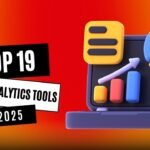
In today’s digital world, understanding your online presence is crucial. Whether you run a small blog or manage a massive e-commerce website, having insights into how visitors interact with your platform can help you make informed decisions. Digital analytics tools are powerful assets that provide information about who visits your site, how they engage with your content, which pages perform best, and what can be improved.
If you’re on the hunt for the best digital analytics tools in 2025, this guide is for you. We’ll break down the top 19 tools, covering the unique features, advantages, and best use cases for each. The aim is to help you find the right analytics tool without confusing you with complex terms. Let’s get started!
What Are Digital Analytics Tools?
Digital analytics tools are software platforms used to measure, analyze, and report on the performance of digital channels like websites, social media, and mobile apps. These tools collect data on user behavior, traffic sources, conversion rates, and more, allowing businesses to gain insights into how people interact with their online content.
Why Digital Analytics Tools Matter?
- Understanding User Behavior: Digital analytics provide a detailed look at how users navigate through a website or app, what content they engage with, and where they drop off. This helps businesses refine user experience and address pain points in the customer journey.
- Optimizing Marketing Campaigns: By tracking metrics such as click-through rates, bounce rates, and conversions, businesses can gauge the effectiveness of marketing campaigns. Analytics tools help identify which channels drive the most traffic and conversions, allowing companies to allocate resources more effectively.
- Enhancing Customer Experience: With insights into what users are looking for and how they interact with content, businesses can tailor experiences that better meet customer needs, leading to higher engagement and satisfaction.
- Boosting Conversions: Analytics data can reveal where visitors abandon the sales funnel, offering clues on where to improve. For example, if many users drop off at the checkout stage, businesses might optimize the checkout process to reduce friction and increase conversions.
- Data-Driven Decision Making: Digital analytics allow businesses to move from intuition-based decisions to data-driven strategies. With concrete metrics, they can test hypotheses, make adjustments, and continuously refine their approach based on what the data suggests.
- Benchmarking and Competitor Analysis: Some tools offer features to compare a business’s performance with industry standards, providing context for their metrics. This helps businesses understand how they’re performing relative to competitors and spot growth opportunities.
- Tracking Return on Investment (ROI): Analytics tools help measure the financial impact of digital activities, showing which campaigns deliver the best ROI. By calculating how much revenue each channel or campaign generates, businesses can better plan future investments.
Top 19 Digital Analytics Tools To Boost Your Online Performance
Here are the top 19 digital analytics tools for 2025 that can empower your business with actionable data:
1. Google Analytics 4 (GA4)
Google Analytics has long been a favorite among marketers and website owners. In 2025, Google Analytics 4, or GA4, continues to lead the pack with its innovative features and capabilities. GA4 was designed to go beyond page views, offering a more comprehensive view of user behavior through “events.”
Key Features of Google Analytics 4
- Event-based Tracking: GA4 doesn’t just measure page views but focuses on events, meaning specific actions users take on your site or app. Events can include things like button clicks, video views, form submissions, and even custom events tailored to your business needs.
- Cross-platform Tracking: GA4 combines data from websites and mobile apps, so you get a unified view of your audience regardless of which platform they use.
- Predictive Analytics: Using machine learning, GA4 can predict future user actions, such as likelihood of purchase or churn (when users stop engaging with your brand).
- User-centric Reporting: GA4 places emphasis on individual user journeys rather than sessions. This means you can see how a user interacts with your brand over time, even if they use different devices.
Why GA4 Stands Out
Google Analytics 4 is designed to help you understand users in a more meaningful way. It’s particularly helpful for businesses that need a free tool that still offers robust analytics, especially if you already use Google Ads. GA4’s insights can inform your ad campaigns, making it easier to target the right audience.
Best For
Websites and businesses of all sizes, especially those who are looking for a free, powerful tool to understand their user behavior across different platforms.
2. Adobe Analytics
If Google Analytics is the “go-to” for free analytics, Adobe Analytics is its premium counterpart. Adobe Analytics is a paid tool known for its advanced capabilities, customization options, and integration with the Adobe suite.
Key Features of Adobe Analytics
- Advanced Segmentation: Adobe allows you to create very specific user segments, so you can study niche audiences and tailor your strategy for them.
- Custom Reports and Dashboards: Adobe Analytics lets you build customized reports, so you only see the data that’s most relevant to your business.
- AI-powered Predictions: Adobe’s AI (called Adobe Sensei) helps predict future trends based on historical data, so you can make proactive business decisions.
- Strong Integration with Adobe Products: If you already use Adobe’s products, such as Adobe Experience Manager or Adobe Target, you can integrate them seamlessly with Adobe Analytics for a unified view of your digital ecosystem.
Why Adobe Analytics Stands Out
Adobe Analytics is incredibly detailed and versatile. It’s particularly popular among larger enterprises because it provides comprehensive data and flexibility. The tool is designed for businesses that need more than just basic insights and are willing to invest in high-quality analytics.
Best For
Large businesses and enterprises that need detailed analytics with customization and are already using other Adobe products.
3. SEMrush
SEMrush is widely recognized as a leading SEO and digital marketing tool, particularly useful for tracking keywords, competitor research, and content strategy. It’s invaluable for those who want to dominate search engine rankings.
Key Features of SEMrush
- Keyword Tracking: Monitor rankings and identify new keyword opportunities to enhance SEO.
- Competitor Analysis: Get insights into your competitors’ search and content strategies, helping you stay one step ahead.
- Content Marketing Tools: SEMrush provides tools for content creation, tracking, and optimization to improve visibility.
- Backlink Analysis: Discover and analyze backlinks to strengthen your website’s authority and SEO performance.
Why SEMrush Stands Out
SEMrush offers a complete suite for digital marketers, providing powerful insights for SEO, paid ads, content, and more. It’s ideal for those who want to improve search engine performance and gain a competitive edge.
Best For
SEO professionals, digital marketers, and businesses looking to strengthen their online presence and outrank competitors.
4. Ahrefs
Ahrefs is primarily an SEO and backlink analysis tool, but it also offers valuable analytics for content creators, marketers, and SEO professionals. It’s best known for its extensive backlink and keyword data.
Key Features of Ahrefs
- Backlink Analysis: Discover who is linking to your site and assess backlink quality.
- Keyword Explorer: Research keyword data to find the best opportunities for ranking.
- Content Explorer: Analyze top-performing content within your industry and find inspiration for new content.
- Site Audit: Identify SEO issues on your website that could impact rankings.
Why Ahrefs Stands Out
Ahrefs is widely used by SEO experts for its robust backlink and keyword tracking capabilities, making it ideal for improving search visibility and content strategy.
Best For
SEO professionals, content marketers, and digital marketers aiming to build strong SEO and content strategies.
5. HubSpot
HubSpot is a well-rounded digital marketing platform that goes beyond just analytics. It integrates customer relationship management (CRM), marketing, and sales tools in one place, making it ideal for businesses that want an all-in-one platform to attract, engage, and delight customers.
Key Features of HubSpot
- CRM Integration: HubSpot connects seamlessly with its own CRM, enabling you to track and manage every customer interaction and build stronger relationships.
- Sales Funnel Analysis: With HubSpot, you can follow leads through the entire sales process and identify where improvements can be made.
- Comprehensive Marketing Tools: Includes email marketing, social media tools, content creation, and lead tracking.
- Customizable Reports and Dashboards: HubSpot’s dashboards make it easy to measure and understand key performance metrics for marketing campaigns.
Why HubSpot Stands Out
HubSpot stands out because it’s more than just analytics—it’s a complete marketing and sales solution. The integration with CRM and marketing automation tools gives businesses a holistic view of their customers and helps them tailor their marketing strategies more effectively.
Best For
Small to mid-sized businesses looking for an all-in-one solution to handle CRM, marketing, and analytics in one platform.
6. Mixpanel
Mixpanel is all about tracking user actions, or “events,” rather than just page views. This tool is especially popular among product teams and developers who want to understand user behavior in-depth.
Key Features of Mixpanel
- Event Tracking: Mixpanel focuses on tracking specific actions users take, like clicking a button or making a purchase. This gives you insight into user behavior at a granular level.
- Real-time Insights: You get data in real-time, which is helpful if you need to make quick decisions or respond to user trends.
- User-friendly Funnels: Mixpanel’s funnels show where users drop off in the conversion process, so you can identify and fix issues in your sales journey.
- A/B Testing and Experimentation: You can test different versions of your product or website to see what drives better engagement.
Why Mixpanel Stands Out
Mixpanel is a strong choice if you’re focused on understanding how people use your product. The tool is great for tracking user actions and creating funnels, helping product managers and developers see how new features are received by users.
Best For
Product managers, developers, and teams looking to improve apps by tracking user interactions closely.
7. Hotjar
Hotjar is a visual tool that provides insights through heatmaps, user recordings, and surveys. It’s unique because it gives you a look at how users navigate your website visually, making it easier to spot problems and improve the user experience.
Key Features of Hotjar
- Heatmaps: Heatmaps show you where users click the most on your website. This is helpful for identifying popular areas and optimizing layouts.
- Session Recordings: With user recordings, you can see real users navigating your site. This feature is invaluable for finding pain points in the user journey.
- Surveys and Polls: Hotjar includes simple survey and poll options, so you can get direct feedback from visitors.
- Feedback Widgets: You can add feedback buttons on your site to allow users to rate their experience or leave comments.
Why Hotjar Stands Out
Hotjar’s visual approach to analytics makes it a favorite among UX (User Experience) designers and website owners. Instead of just seeing numbers, you get a real look at how users engage with your site, which is helpful for spotting issues quickly.
Best For
UX designers and website owners who want a visual understanding of user behavior to improve the user experience.
8. Sprout Social
Sprout Social is a leading social media analytics tool that offers powerful insights into social engagement, audience behavior, and brand health. It’s ideal for brands and agencies looking to improve their social media strategies.
Key Features of Sprout Social
- Social Listening: Track brand mentions and conversations on social media to stay updated on what people are saying.
- Audience Analytics: Get insights into your followers’ demographics and engagement patterns.
- Detailed Platform-Specific Analytics: Access analytics for individual platforms like Twitter, Facebook, Instagram, and LinkedIn.
- Content Scheduling and Performance Tracking: Schedule posts across platforms and analyze the performance to optimize social content.
Why Sprout Social Stands Out
Sprout Social combines analytics with social media management tools, making it a powerful all-in-one platform for social media managers who need to measure, analyze, and optimize their strategies.
Best For
Social media managers, digital marketers, and brands looking to enhance their social media presence and track engagement.
9. BuzzSumo
BuzzSumo specializes in content and social media analytics, helping marketers discover trending topics, top-performing content, and key influencers in their niche.
Key Features of BuzzSumo
- Content Discovery: Find popular content and topics that are resonating with audiences.
- Social Media Analytics: Track how often content is shared across social platforms and identify what topics drive engagement.
- Influencer Identification: Discover influencers within your industry to amplify your brand reach.
- Competitor Analysis: Analyze competitor content strategies and see what’s working for them.
Why BuzzSumo Stands Out
BuzzSumo is an excellent tool for content creators and marketers who want to develop engaging content strategies. It’s invaluable for discovering what resonates with audiences and identifying industry trends.
Best For
Content marketers, social media managers, and brands aiming to improve content visibility and engagement.
10. Amplitude
Amplitude focuses on user behavior and is widely used by teams who want to dig deep into understanding their audience. Amplitude helps you see the entire journey a user takes, making it easy to identify what drives engagement.
Key Features of Amplitude
- User Journey Analysis: Amplitude shows you how users move through your site or app, helping you understand the paths they take to achieve goals.
- Customizable Funnels and Cohorts: You can create funnels and track user behavior based on characteristics like frequency of visits or actions taken.
- A/B Testing Integration: Test different strategies to see what improves engagement and make changes based on real data.
- Retention Analysis: Amplitude helps you understand which features keep users coming back, which is key for improving long-term engagement.
Why Amplitude Stands Out
Amplitude’s focus on user journeys makes it a popular choice for product teams and marketers who want to understand what drives retention and engagement. It’s especially useful for tracking long-term trends and making data-backed decisions.
Best For
Businesses focused on user engagement, retention, and improving customer journeys.
11. Kissmetrics
Kissmetrics is a behavior analytics tool that helps businesses track individual users over time. It’s particularly popular among e-commerce businesses that want to understand the complete customer journey.
Key Features of Kissmetrics
- User-level Tracking: Kissmetrics focuses on individual users, allowing you to see how people move through your website over time.
- Revenue-focused Reports: The tool includes reports tailored to understanding revenue, like customer lifetime value, so you can measure financial impact.
- Customizable Funnels: You can create funnels to see where users drop off and how to optimize the user journey.
- A/B Testing: Test different changes to see what helps increase engagement and conversions.
Why Kissmetrics Stands Out
Kissmetrics is a favorite for e-commerce sites because it focuses on tracking individual user behavior, which is helpful for understanding repeat visits and purchases. Its revenue-focused reports are valuable for businesses looking to increase profits.
Best For
E-commerce sites and businesses interested in tracking customer journeys and maximizing revenue.
12. Crazy Egg
Crazy Egg is a user-friendly visual analytics tool known for its heatmaps and user recordings. It offers an intuitive way to understand user behavior on your website without diving into complex data.
Key Features of Crazy Egg
- Heatmaps: Visualize where users click the most on your site, helping identify which elements capture attention.
- Scroll Maps: See how far users scroll down pages, revealing which content engages users and which gets ignored.
- User Recordings: Watch actual user sessions to understand behavior and identify issues in the user journey.
- A/B Testing: Experiment with different design and layout changes to see which versions perform best.
Why Crazy Egg Stands Out
Crazy Egg’s simplicity and ease of use make it a favorite for UX designers and small businesses. It’s particularly valuable for visualizing user interactions and testing design changes to improve engagement.
Best For
UX designers, web developers, and small businesses needing visual insights to improve user experience.
13. Heap Analytics
Heap Analytics is a popular tool for its ease of use and automatic tracking capabilities. Unlike other tools, Heap tracks nearly everything by default, so you don’t have to manually set up events.
Key Features of Heap Analytics
- Automatic Event Tracking: Heap automatically captures every interaction users make with your site or app, without requiring manual tagging.
- Retroactive Analysis: Because Heap tracks everything, you can go back and analyze past user interactions even if you hadn’t set up specific events before.
- Custom Funnels and Paths: You can create custom funnels to see user journeys and figure out where users drop off.
- Data Visualization: Heap provides clear visual reports that make it easy to understand user behavior without sifting through raw data.
Why Heap Stands Out
Heap is incredibly convenient for teams that want insights without spending a lot of time on setup. Since it automatically tracks all actions, you don’t have to worry about missing data, and the retroactive reporting is a big plus for businesses looking to revisit past trends.
Best For
Teams that want quick setup, automatic tracking, and a lot of flexibility with minimal manual setup.
14. Matomo
Matomo is a privacy-focused web analytics tool that’s popular for its commitment to data ownership and GDPR compliance. It’s an excellent alternative to Google Analytics for those who prioritize data privacy.
Key Features of Matomo
- Data Ownership and Privacy: Matomo ensures that you own all your data, making it suitable for GDPR and other privacy laws.
- On-premise or Cloud Hosting: You can choose to host Matomo on your own server or in the cloud, giving flexibility for different data storage needs.
- Comprehensive Analytics: Matomo offers a full range of analytics, including heatmaps, user journeys, goal tracking, and more.
- Customizable Reports: Create and tailor reports to focus on the data that matters most for your business.
Why Matomo Stands Out
Matomo’s focus on data privacy sets it apart. It provides nearly all the functionality of Google Analytics, but with the added benefit of complete control over your data.
Best For
Businesses that need a privacy-complaint analytics tool with full data ownership and control.
15. Piwik PRO
Piwik PRO is a privacy-focused analytics tool that gives users full control over their data. It’s an excellent choice for businesses that handle sensitive information or are concerned with data privacy.
Key Features of Piwik PRO
- Privacy-focused: Piwik PRO complies with privacy regulations, such as GDPR, and gives you full control over your data.
- On-premise or Cloud: You can choose to host Piwik PRO on your own server for added security or use their cloud service.
- Customizable Reports: Piwik PRO offers flexible reports that can be customized to your specific needs.
- All-in-one Platform: Piwik PRO includes features like heatmaps, session recordings, and user paths, making it a comprehensive analytics tool.
Why Piwik PRO Stands Out
Privacy is becoming increasingly important, and Piwik PRO stands out because it gives businesses full control over their data. It’s ideal for companies that want to prioritize data privacy without sacrificing analytics capabilities.
Best For
Businesses handling sensitive data, such as in finance or healthcare, that need strict privacy controls.
16. Chartbeat
Chartbeat is designed for publishers and content-heavy websites. It provides real-time insights into how users engage with content, making it perfect for news sites, blogs, and media outlets.
Key Features of Chartbeat
- Real-time Data: Chartbeat shows real-time engagement data, which is crucial for content-heavy sites that need to know what’s popular right now.
- Engagement Metrics: The tool provides metrics that show how much time readers spend on articles, where they scroll, and what content keeps them engaged.
- Headlines Testing: Chartbeat lets you test headlines to see which ones attract more clicks and engagement.
- Loyalty Insights: It also tracks reader loyalty, helping you understand how many users return to your site regularly.
Why Chartbeat Stands Out
Chartbeat’s focus on real-time data and engagement metrics makes it ideal for content-heavy sites that need instant insights. It’s perfect for anyone who wants to improve content and optimize headlines for maximum clicks.
Best For
Publishers, media outlets, and content-heavy websites that want real-time insights into content engagement.
17. Woopra
Woopra is a customer journey analytics tool that focuses on tracking user behavior across multiple touchpoints. It’s ideal for companies that want a detailed look at the full customer lifecycle.
Key Features of Woopra
- Real-time Customer Journeys: See how users move through your platform across multiple sessions and touchpoints.
- Customizable Reports: Generate custom reports tailored to specific user actions and business goals.
- Integrations with Other Tools: Woopra integrates with popular tools like Salesforce, Slack, and Zendesk to provide a unified view of customer data.
- Retention Analysis: Track user retention and engagement over time to identify which features keep customers coming back.
Why Woopra Stands Out
Woopra stands out for its focus on customer journey tracking, making it ideal for companies wanting to understand and improve the complete user experience from initial contact to conversion.
Best For
Customer experience teams, product managers, and marketers interested in tracking user behavior across the full lifecycle.
18. Funnel
Funnel is a data integration and reporting tool that helps businesses combine data from multiple marketing platforms into one unified dashboard. It’s designed to streamline data management and reporting.
Key Features of Funnel
- Data Integration: Connects with hundreds of marketing platforms and consolidates data into a single view.
- Customizable Dashboards: Create dashboards tailored to specific metrics and business goals.
- Automated Reporting: Generate and share reports automatically, saving time and reducing manual data entry.
- Data Normalization: Standardizes data from multiple sources, making it easier to analyze.
Why Funnel Stands Out
Funnel simplifies the process of combining data from multiple platforms, making it easy for businesses to get a holistic view of their marketing efforts without manual data manipulation.
Best For
Marketing teams and businesses need a unified view of data from multiple sources to simplify reporting and analysis.
19. Clicky
Clicky is a user-friendly web analytics tool that provides real-time data and simple yet insightful metrics. It’s ideal for users who want a straightforward alternative to Google Analytics.
Key Features of Clicky
- Real-time Data: Track visitor activity as it happens, with instant updates on traffic and interactions.
- Heatmaps: Visualize where users click most on your site, making it easy to optimize layouts.
- Visitor Segmentation: Segment visitors by behaviors and view detailed profiles for deeper insights.
- Uptime Monitoring: Check your site’s uptime and get alerts if your site goes down.
Why Clicky Stands Out
Clicky offers simplicity and ease of use, which makes it a great choice for small business owners or beginners who need fast and effective insights without the complexity of larger analytics platforms.
Best For
Small businesses, bloggers, and beginners looking for a straightforward web analytics tool with real-time data.
How To Choose The Right Digital Analytics Tool?
Now that we’ve explored the top tools, how do you pick the best one for your needs? Here are some quick tips:
- Define Your Goals: Identify what you need the tool to accomplish. Are you looking to track website traffic, understand user behavior, or measure conversions? Clear goals will help narrow down the options, as some tools are better suited for in-depth user analytics, while others focus on website or marketing performance.
- Consider Your Budget: Digital analytics tools come in a wide range of prices, from free options like Google Analytics to premium platforms like Adobe Analytics or Amplitude. Ensure the tool fits within your budget while still providing the features you need. Often, paid tools offer advanced features such as predictive analytics, enhanced data visualization, and cross-channel attribution.
- Evaluate Ease of Use and Learning Curve: Some tools are more complex than others, requiring technical knowledge to fully leverage their features. If your team is new to analytics, consider a user-friendly tool with accessible training resources. Google Analytics, for example, is widely used and has plenty of tutorials and certifications available.
- Scalability and Customization: Choose a tool that can grow with your business. Ensure it can handle increased data volumes and offers customization options to adapt to your evolving needs. Tools like Mixpanel and Adobe Analytics provide customizable dashboards and reports, making it easy to tailor them as you scale.
- Data Accuracy and Reliability: Accurate data is crucial for making informed decisions. Look for tools known for their reliability and ensure they have mechanisms for dealing with data discrepancies, such as spam filtering, bot detection, and customizable filters. A tool that integrates well with your existing platforms, like CRMs or marketing automation software, can improve accuracy by providing a unified data view.
- Integration Capabilities: The tool should seamlessly integrate with your existing tech stack, such as your CRM, social media, and email marketing platforms. Strong integration capabilities will allow for a more comprehensive view of customer behavior across multiple channels, helping you make more data-driven decisions.
- Privacy and Compliance: With privacy regulations like GDPR and CCPA, it’s essential to choose a tool that complies with data protection laws and provides options for data anonymization, consent management, and opt-outs. Verify that the tool has robust privacy features to protect user data and help your business stay compliant.
- Customer Support and Community: Look into the level of customer support offered, especially if your team is new to analytics. Reliable customer support and a strong user community can be incredibly helpful in troubleshooting issues and maximizing the tool’s potential.
- Reporting and Visualization: Effective data visualization and reporting capabilities can make it easier to understand and act on insights. Look for a tool with customizable, intuitive dashboards and the ability to create detailed, visually appealing reports. Many tools, like Tableau and Looker, excel in data visualization and can often integrate with analytics platforms.
- Free Trials and Demos: Take advantage of free trials or demos to see if the tool meets your needs. This hands-on experience can give you a feel for the tool’s usability, features, and interface, helping you make an informed decision.
Conclusion
In 2025, digital analytics tools have never been more essential for businesses aiming to understand customer behavior, optimize strategies, and drive meaningful results. From advanced AI-powered insights to user-friendly platforms, each tool offers unique features that can cater to various needs—from in-depth data analysis and customer journey mapping to real-time reporting and seamless integration with other business systems.
The tools listed here reflect a wide range of capabilities that enable marketers, analysts, and decision-makers to make data-driven choices with confidence. As you explore these tools, consider your organization’s specific goals, budget, and team needs to select the right fit. With the right digital analytics tool in your toolkit, you’re well on your way to a more informed, efficient, and impactful 2025.








No Comments